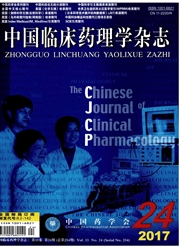

 中文摘要:
中文摘要:
目的探讨吸入型糖皮质激素对哮喘患儿的临床疗效及作用机制。方法 90例哮喘患儿随机分为试验组与对照组,各45例。对照组给予常规治疗,试验组在常规治疗基础上给予吸入型糖皮质激素治疗,5岁以下患儿给予丙酸氟替卡松气雾剂100.0-250.0μg·d-(-1)雾化治疗,每天2次;5岁以上患儿给予布地奈德气雾剂200.0-400.0μg·d-(-1)雾化治疗,每天2次。连续治疗4周,观察2组患儿的临床疗效和血清神经营养素-3、外周血嗜酸性粒细胞的变化。结果试验组总有效率为95.56%,对照组总有效率为71.11%,试验组显著优于对照组(P〈0.05)。治疗后,试验组与对照组血清神经营养素-3和外周血嗜酸性粒细胞较治疗前显著降低,试验组降低程度较对照组更显著(P〈0.05)。结论哮喘患儿治疗的过程中加用糖皮质激素能提高临床疗效,其机制可能是降清血清神经营养素-3和外周血嗜酸性粒细胞计数,控制气道炎症反应。
 英文摘要:
英文摘要:
Objective To investigate the clinical efficacy of inhaled stereoscopic on asthma in children and its mechanism. Methods Ninety children with asthma were divided into treatment group and the control group,45 cases in each group. The control group received conventional treatment,and treatment group received inhaled corticosteroid therapy on the basis of conventional therapy,children under 5 years old were given fluticasone propionate inhalation aerosol spray treatment,100. 0-250. 0μg·d-1,2 times a day; children older than 5 years were given budesonide inhalation therapy,200. 0-400. 0 μg·d-1,2 times a day. Treatment lasted for four weeks,the clinical efficacy,serum neurotrophin-3( NT-3),and the changes of peripheral blood eosinophils( EOS) of two groups were observed. Results The total effective rate was 95. 56% in treatment group,significantly higher than that in control group,which was71. 11%. After treatment,the levels of NT-3 and EOS of two groups were significantly reduced than those before treatment, but treatment group decreased more than control group( P〈0. 05). Conclusion Taking inhaled stereoscopic in the treatment process of pediatric asthma can improve clinical outcomes. Its mechanism of action might be that it reduced the serum neurotransmitter-3 and peripheral blood anglophile count,controlled airway inflammation,and thereby,further improved the clinical efficacy.
 同期刊论文项目
同期刊论文项目
 同项目期刊论文
同项目期刊论文
 期刊信息
期刊信息
